Imperial leather - Study guides, Class notes & Summaries
Looking for the best study guides, study notes and summaries about Imperial leather? On this page you'll find 10 study documents about Imperial leather.
All 10 results
Sort by

-
Intersections of Race, Gender, and Power: Analyzing Nella Larsen’s Passing and Anne McClintock’s Imperial Leather
- Summary • 4 pages • 2024
-
- $7.99
- + learn more
Explore the complex interplay between race, gender, and imperialism in this insightful short answer response, which delves into Nella Larsen’s Passing and Anne McClintock’s “Imperial Leather.” This document analyzes how historical forces and colonial ideologies shape racial identity, power dynamics, and societal norms. By synthesizing the personal experiences of characters like Irene Redfield and Clare Kendry with McClintock’s theoretical framework, this response uncovers the enduring ...

-
Ultimate AP World History Exam Review Latest Update 2023
- Exam (elaborations) • 106 pages • 2023
-
Available in package deal
-
- $15.49
- + learn more
Ultimate AP World History Exam Review Mohandas K. Gandhi - led indian campaign for home rule focused on nonviolence Amritsar - city in N. India, British officers ordered masssacre of peaceful protestors in 1919. Muhammad Ali Jinnah - lawyer who became head of muslm league, wanted india to be devided into muslim and hindu regions Bal Gangadhar Tilak - founder of hindu nationalism. Helped lay groundwork for independence movement in India Sun Yatsen - Leader of revolution that ended ...

-
Sophia pathway US History I Milestone 1. You passed this Milestone
- Exam (elaborations) • 20 pages • 2023
-
- $9.49
- + learn more
Sophia pathway US History I Milestone 1. You passed this Milestone 16 questions were answered correctly. 8 questions were answered incorrectly. 1 question was skipped. These were marked incorrect. 1 Which of the following describes North American Indians prior to European contact? RATIONALE The Aztec constructed elaborate temples in their capital city, Tenochtitlán. The Inca had no system of writing, but communicated and kept records using a system called quip...
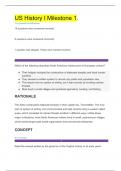
-
US History I Milestone 1.
- Exam (elaborations) • 20 pages • 2024
-
- $10.48
- + learn more
US History I Milestone 1. You passed this Milestone 16 questions were answered correctly. 8 questions were answered incorrectly. 1 question was skipped. These were marked incorrect. 1 Which of the following describes North American Indians prior to European contact? RATIONALE The Aztec constructed elaborate temples in their capital city, Tenochtitlán. The Inca had no system of writing, but communicated and kept records using a system called quipu, which consis...
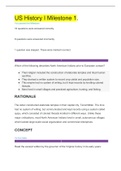
-
US History I Milestone 1.
- Exam (elaborations) • 20 pages • 2022
-
- $12.99
- + learn more
US History I Milestone 1. You passed this Milestone 16 questions were answered correctly. 8 questions were answered incorrectly. 1 question was skipped. These were marked incorrect. 1 Which of the following describes North American Indians prior to European contact? RATIONALE The Aztec constructed elaborate temples in their capital city, Tenochtitlán. The Inca had no system of writing, but communicated and kept records using a system called quipu, which consis...
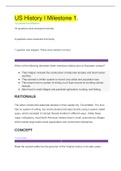
-
US History I Milestone 1
- Exam (elaborations) • 20 pages • 2023
-
- $16.99
- + learn more
US History I Milestone 1. You passed this Milestone 16 questions were answered correctly. 8 questions were answered incorrectly. 1 question was skipped. These were marked incorrect. 1 Which of the following describes North American Indians prior to European contact? RATIONALE The Aztec constructed elaborate temples in their capital city, Tenochtitlán. The Inca had no system of writing, but communicated and kept records using a system called quipu, which consis...
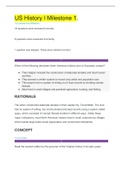
-
US History I Milestone 1.
- Exam (elaborations) • 20 pages • 2022
-
- $12.49
- + learn more
US History I Milestone 1. You passed this Milestone 16 questions were answered correctly. 8 questions were answered incorrectly. 1 question was skipped. These were marked incorrect. 1 Which of the following describes North American Indians prior to European contact? RATIONALE The Aztec constructed elaborate temples in their capital city, Tenochtitlán. The Inca had no system of writing, but communicated and kept records using a system called quipu, which consis...
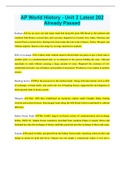
-
AP World History - Unit 2
- Exam (elaborations) • 5 pages • 2022
-
- $9.49
- + learn more
AP World History - Unit 2 Latest 202 Already Passed Kashgar was an oasis city and major trade hub along the great Silk Road as the northern and southern Silk Routes crossed here and caravans departed for Central Asia, India, Pakistan and ancient Persia (current Iran.) Kashgar has been under the rule of the Chinese, Turkic, Mongol, and Tibetan empires. Known even today by its large and diverse markets. Bills of exchange a written order without interest which binds one party to pay a fixed sum to...

-
US History I Milestone 1
- Exam (elaborations) • 20 pages • 2022
-
- $15.49
- + learn more
US History I Milestone 1. You passed this Milestone 16 questions were answered correctly. 8 questions were answered incorrectly. 1 question was skipped. These were marked incorrect. 1 Which of the following describes North American Indians prior to European contact? RATIONALE The Aztec constructed elaborate temples in their capital city, Tenochtitlán. The Inca had no system of writing, but communicated and kept records using a system called quipu, which consis...
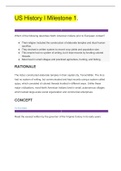
-
US History I Milestone 1. 2022
- Exam (elaborations) • 20 pages • 2022
-
- $15.49
- + learn more
US History I Milestone 1. 1 Which of the following describes North American Indians prior to European contact? RATIONALE The Aztec constructed elaborate temples in their capital city, Tenochtitlán. The Inca had no system of writing, but communicated and kept records using a system called quipu, which consisted of colored threads knotted in different ways. Unlike these major civilizations, most North American Indians lived in small, autonomous villages which lacked large-sca...

Study stress? For sellers on Stuvia, these are actually golden times. KA-CHING! Earn from your study resources too and start uploading now. Discover all about earning on Stuvia


